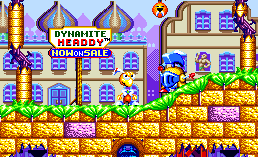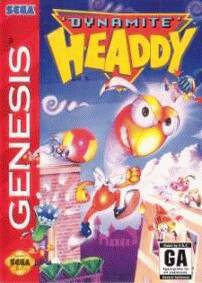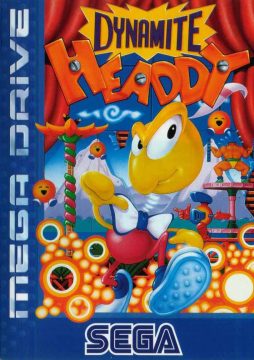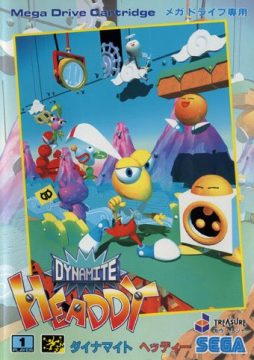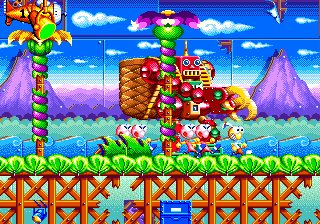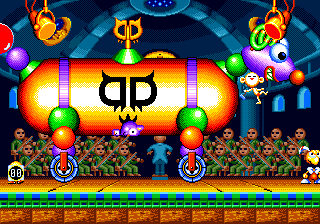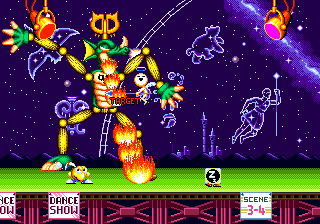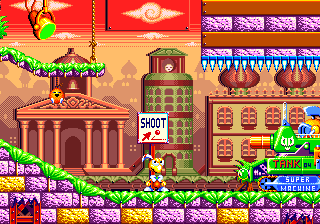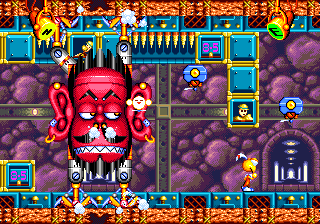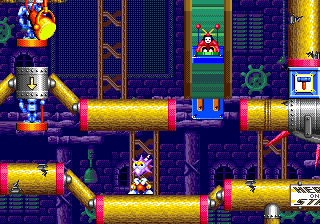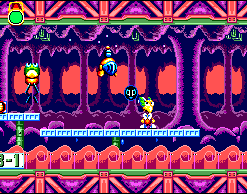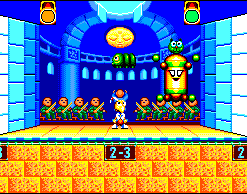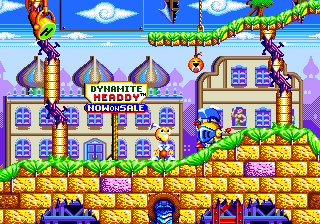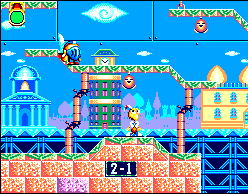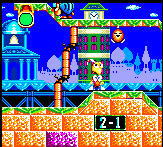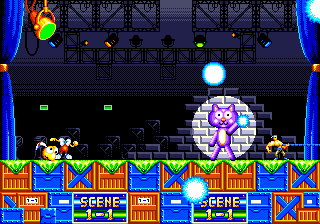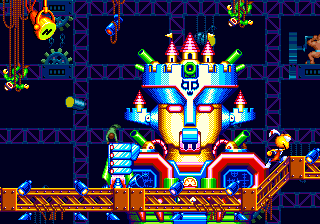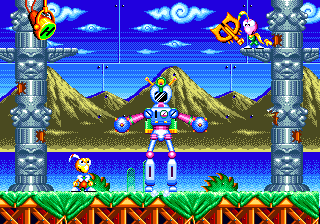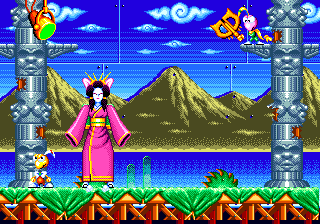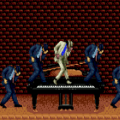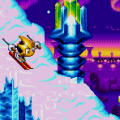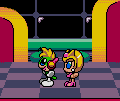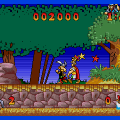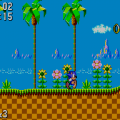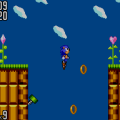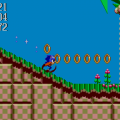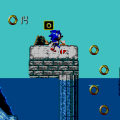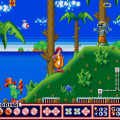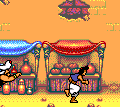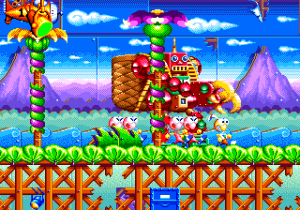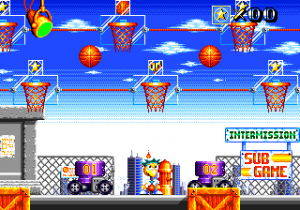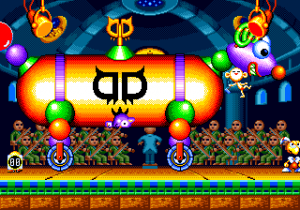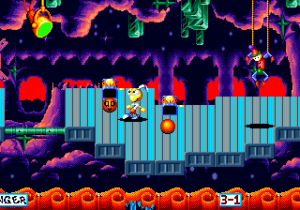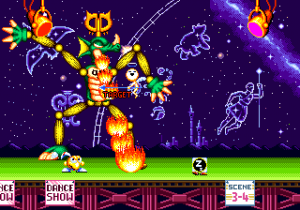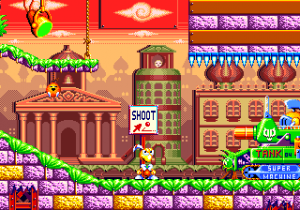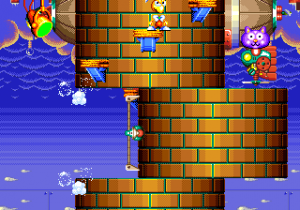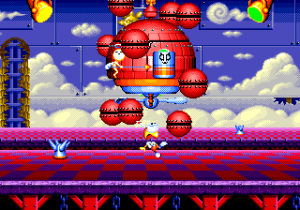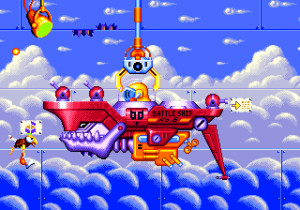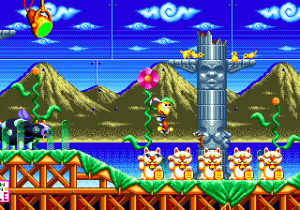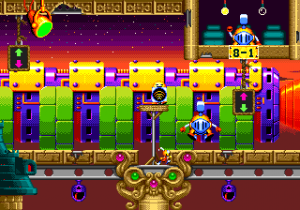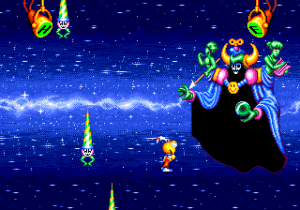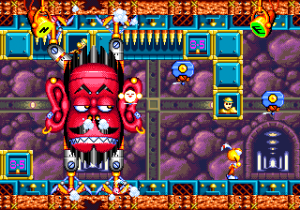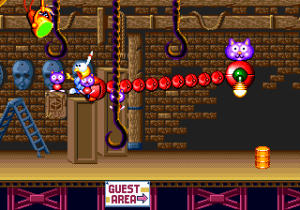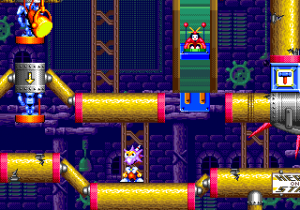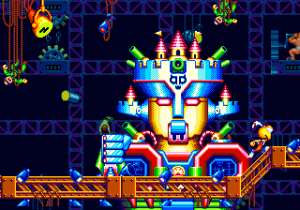Dynamite Headdy was Treasure’s second foray into an original IP. Like its immediate predecessor, it is a side-scrolling platform game stuffed with some interesting mini-games and boss encounters. Though critically acclaimed, it never reached mainstream US popularity, much like the more recent Beyond Good & Evil and Psychonauts. Partially a victim of its time, Dynamite Headdy was released into an unforgiving market suffering through a deluge games starring wannabe mascot characters dropped into run-of-the-mill platform games. Well, that and the fact that it is a textbook example of Japanese quirk released at a time when the market was not quite ready for it. What most gamers missed here was yet another game that made an attempt to innovate in mechanics and further refine the level design of its genre; all while remaining a blast to play.
Dynamite Headdy has its central gameplay element imbedded in its title. While also being the protagonist’s name, the “Headdy” refers to the fact that your head is your weapon. Pressing the B button sends Headdy’s cranium out about 3 feet or so in front of him to bash enemies. He can fire it in 8 directions, and can grab and pull himself up onto platforms using his beak-like mouth, similar to Ronald’s handkerchiefs in McDonald’s Treasure Land Adventure, another Treasure game for the Genesis. Additionally, Headdy can pick up a slew of optional heads, each having a unique and different power. A Hammer Head amplifies attack power and can destroy certain blocks. The Vacuum Head lets you suck up both enemies and power-ups Kirby-style. The Spiked Head lets you scale walls. Certain heads will make you temporarily invincible, shrink in size or stop time. There are eighteen heads altogether, including the three you can use in the side-scrolling shooter stage.
You’re usually given a choice of two or three heads at various points, which can potentially alter the course you take through a level. A couple of bosses require efficiently managing which heads to choose and when. However, these opportunities feel a bit underutilized. This is a bit of a negative, as the individual powers are not at all as essential as one would expect them to be, and you spend most of the game with your standard vanilla head. On the other hand, this isn’t necessarily a bad thing – if the heads were given too much of the spotlight, it would have killed the frantic flow of the game, creating more opportunities for unnecessary frustration/irritation. As it stands, Dynamite Headdy is an archetype of the action-platform genre. It is quite beautiful too.
Yet again, the eyes are blessed with the excellent graphics that have become a trademark for Treasure’s Genesis games. The whole game is filled with impossibly colorful (64 colors? Are you sure?), diverse, strange lands, filled with oodles of effects…and smiley faces. The game has the trappings of a whacked-out Kabuki theater – the characters are supposed to be puppets come to life – staffed by miniature musclemen, enveloping the disparate, abstract, dare I say, “trippy” landscapes of the levels. All of the little things going on in the backgrounds are some of the best treats the game has to offer. The game is filled with signs for Sega, Treasure, and even bits that advertise the game itself. They even routinely show off the stage number as part of the background. From miniature sumo wrestlers to technical delights like platforms that rotate convincingly on the Z-axis forcing you to keep your balance, the game never stops surprising the player. Each level also has a number of secret areas and bonus, the discoveries of which are tallied at the end of the stage. It’s a small bit, but it encourages the player to explore everywhere to obtain a “perfect” game, which adds greatly to the replayability.
Headdy himself is a fairly interesting and well animated character, with a detached head floating above his body in a way similar to that of the limbs of Ubisoft’s Rayman; so much so that Michel Ancel’s creation is almost plagiarism. There are all kinds of funny little touches in Headdy’s movements, such as his head-juggling idle animation, the goofy grin on his face when he’s running, or the strangely angry look he wears when he sits still – these all give him a life of his own. He’s even accompanied by a female compatriot named Heather (Fingy in Japanese version) and aided by a strange flying angel which will point out boss weakpoints by yelling “TARGET!”
The enemy design is solid, if a bit scattershot, and the bosses are up to the pattern-heavy standard of excellence established with Gunstar Heroes. They come frequently, and are almost always pretty cool. A recurring foe is a cat/bear thing called Trouble Bruin (Maruyama in the Japanese version) which shows up a variety of crazy contraptions to wreak havoc. The second boss is a gigantic toy dog, which you fight while an orchestra plays “The Nutcracker” in the background. One of the coolest is a pseudo-homage to the second miniboss from the first stage of Gunstar Heroes (the block man on top of the pyramid). In Headdy, there is a wooden mannequin who poses and moves in a way similar the Gunstar Heroes miniboss, but changes between several outfits that range from a Godzilla-esque dinosaur to a ballerina. It is delightfully strange, and the battle itself is extremely well-designed and satisfying. Great stuff.
Aurally, the game is about on par with McDonald’s Treasure Land Adventure. The demented amusement park is in town, though most of the melodies aren’t as memorable. The music is well arranged and sounds great, but it just isn’t all that exciting. It complements the action and that’s about it. The sound effects are also well done, but special note must be made of the voices. Voice samples are occasionally used in the game for various reasons and they are all of surprisingly excellent quality. None of that tinny Mega Drive scratchiness is apparent and they all have a slight reverb effect that is quite cool.
The World (American/European) version of the game is a bit different than the Japanese original; more so than most of the domestically released Treasure games. For starters, the Japanese version is quite a bit easier – the World version has bosses with tougher attack patterns that take more hits to kill. In both games, you need to earn continues by picking up the exploding objects that pour out of defeated bosses – however, in the Japanese version, you start with two continues, while you begin with none in the World version.
These changes are frustrating – Dynamite Headdy is not a short game, clocking in at nine stages, with several sub areas and numerous difficult boss fights. It’s tough to restart the game from scratch, although thankfully a level select in both versions alleviates some annoyance. The original Japanese release had a nice balance happening. It was challenging, but doable, much like Gunstar Heroes. Unfortunately, the changes to the World version does nothing more than increase frustration and minimize enjoyment. It is not as bad as say, the Working Designs release of Exile: Wicked Phenomenon for the TurboGrafx CD, but it is definitely a negative, and may have also contributed to the game’s not quite Earth-shattering sales figures. Due to this fact alone, it’s probably more worthwhile to grab the import.
Additionally, the Japanese version has plenty of dialogue that appears before boss fights. Nearly all of these were removed from the World version. This also drastically alters the ending – in the World version, Headdy is simply hugged by his gal pal Heather, while the Japanese versions adds quite a bit more. All of the levels have different names, though they’re written in English in both versions. The Japanese version has generic titles, but nearly all of the levels in the World version are jokes from popular movies (“Toys n the Hood”, “Terminate Her Too”, “Stair Wars”, “Fly Hard”, “The Rocker Tier”, “Illegal Weapon 3”, “Fun Forgiven”, and a host of other groaners.)
Several characters and bosses were changed too. Trouble Bruin in the World version has an evil look on his face at all times, but his Japanese equivalent, Maruyama, looks substantially cuter. Two other bosses were also given overhauls. In the Japanese version, you fight against a giant doll in Stage 2-1. This was changed into a gigantic robot for the World version. Later on, in Stage 7, you fight a female Japanese dancer. This was also changed into a different robot in the World version, perhaps because it portrayed violence against female-ish characters. There’s also a wacky secret ending if you beat all of the bonus stages – an odd variation on basketball – and remember the secret code. In this ending, you face off against the theater owner and a group of his thugs.
Usually when one needs a Treasure fix, the likes of Gunstar Heroes, Guardian Heroes and Radiant Silvergun, among others, tend to jump out at me over Dynamite Headdy. It’s shameful, but I am quite sure that I am not the only person who has experienced this. Dynamite Headdy is a near-forgotten gem that is most definitely worth a playthrough for anyone who loves 2D side-scrolling platform games. It will keep you on your toes with its challenge, and all the little touches found throughout are more than enough reward for your perseverance.
There are also ports of Dynamite Headdy for the Game Gear and Sega Master System. Sega had a habit of releasing “ports” for the Game Gear late in its life that were simply Master System games on a GG cartridge (Chase H.Q. is a fine example of this practice), but the Game Gear version of Headdy actually came before the Master System game. Unlike the rumored (and debunked) Gunstar port, Headdy was actually released for the Master System in Brazil by Tec Toy and is a moderately different game than the GG version, especially in the visual department. Most notably, the color palette has been altered and the visuals look quite a bit brighter. Uncharacteristically, the GG version appears to be the original source in this instance as the stage layouts are about the same.
As for the games themselves, they are both scaled-back, but adequate conversions that offer a nice snapshot of what Headdy was all about, but are a bit unnecessary if one has the ability to play the far superior Genesis original. The levels have been truncated, with sections shortened or cut out entirely. The boss encounters have also been changed. In the second level of the Genesis game, Trouble Bruin/Maruyama begins to fight, but is instead squashed by a gigantic toy dog. In the SMS/GG version, you’ll actually fight him without any interruptions. There are also far less heads to use in the SMS/GG version.
The Game Gear version was released in all territories and can be had for a pittance due to most collectors’ aversion to the GG. The Japanese version is a bit pricier due to the fact that the only place to buy imports for the system seems to be eBay. The Master System game on the other hand, was only released in Brazil and carries a price tag far beyond its worth to anyone other than a serious collector. It has remained below the magic $100 mark thus far, but is in demand and does not show up on eBay very often.
There is a brighter side to this situation though. Like the GG Gunstar Heroes, both 8-bit ports of Dynamite Headdyare hidden in the Sega Ages Vol. 25: Gunstar Heroes Treasure Box for the PS2, with enhancements. It is especially nice to have the privilege of playing the GG version on a large, sharp TV screen with a Saturn pad rather than on the blurry GG screen. Even so, both of these ports, though reasonably close to the 16-bit original, are really just a curiosity at this point.
Dynamite Headdy is also available on the Wii Virtual Console, as part of Sonic’s Ultimate Genesis Collection for Xbox 360 and PS3, and was released on Steam.
Screenshot Comparisons
Regional Differences
